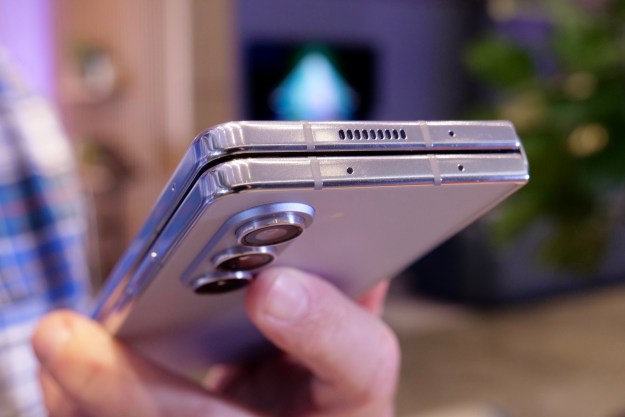Microsoft released a series of new portable powerhouse products at its Surface event, including the next generation of their mobile line, the Microsoft Surface Duo 2. This is the successor to the much-criticized Surface Duo, which received negative reviews and lackluster sales due to issues with subpar hardware and software. With the Duo 2, Microsoft has taken criticism to heart and revamped it with flagship-level hardware and promises of an improved software experience.
The Duo 2 now joins other foldable phones like the Samsung Galaxy Z Fold 3, which is widely considered to be one of the best on the market in terms of performance and features, and the compact, consumer-friendly Galaxy Z Flip 3. The specs between the Duo 2 and Fold 3 are similar in most regards, but there are some key differences, and Samsung has generally had more experience when it comes to folding-phone hardware. There’s also a price disparity, with the Galaxy Z Fold 3 costing an extra $300 over the Duo 2. Read on to see our breakdown of how they differ and which one is better.
Specs
| Microsoft Surface Duo 2 | Samsung Galaxy Z Fold 3 | |
| Size | Open: 145.2 x 184.5 x 5.5mm (5.71 x 7.26 x 0.22 inches)
Closed: 145.2 x 92.1 x 11.0mm (5.71 x 3.62 x 0.43 inches) |
Unfolded: 128.1 x 158.2 x 6.4mm (5.04 x 6.22 x 0.25 inches)
Folded: 67.1 x 158.2 x 16.0mm (2.64 x 6.22 x 0.63 inches) |
| Weight | 284 grams (10.01 ounces) | 271 grams (9.56 ounces) |
| Screen size | Open: 8.3-inch Dual PixelSense Fusion Display AMOLED (90Hz)
Closed: 5.8-inch PixelSense Display AMOLED |
Main: 7.6-inch Dynamic AMOLED 2X (120Hz)
Cover screen: 6.2-inch Super AMOLED 2X (120Hz) |
| Screen resolution | Open: 2688 x 1892 (396 pixels per inch)
Closed: 1344 x 1892 (401 ppi) |
Main: 2208 x 1768 pixels (374 ppi)
Cover screen: 2268 x 832 pixels (387 ppi) |
| Operating system | Android 11 | Android 11 with One UI 3.1 |
| Storage | 128GB, 256GB, 512GB | 256GB, 512GB |
| MicroSD card slot | No | No |
| Tap-to-pay services | Google Pay | Samsung Pay, Google Pay |
| Processor | Qualcomm Snapdragon 888 | Qualcomm Snapdragon 888 |
| RAM | 8GB | 12GB |
| Camera | Rear: 16-megapixel ultrawide, 12MP wide-angle, 12MP telephoto
Front: 12MP |
Rear main: 12MP ultrawide, 12MP wide-angle, and 12MP telephoto rear
Front main screen: 4MP under-display Cover screen: 10MP |
| Video | 4K at 60 frames per second, 1080p at 240 fps, slow motion at 240 fps, HDR | 4K at 60 fps, 1080p at 240 fps, 720p at 960 fps, HDR10+ |
| Bluetooth version | Bluetooth 5.1 | Bluetooth 5.1 |
| Ports | USB-C | USB-C |
| Fingerprint sensor | Yes, side-mounted | Yes, side-mounted |
| Water resistance | No | IPX8 |
| Battery | 4,449mAh dual battery
Fast Charging with Microsoft Surface 23W USB-C |
4,400mAh
Fast charging (25W, charger not included) Fast wireless charging (10W) Reverse wireless charging (4.5W) |
| App marketplace | Google Play Store | Google Play Store, Samsung Galaxy Store |
| Network support | All major carriers | All major carriers |
| Colors | Glacier, Obsidian Black | Mirror Purple, Mirror Black |
| Prices | $1,500 | $1,800 |
| Review |
3.5 out of 5 stars | 4 out of 5 stars |
Design, display, and durability
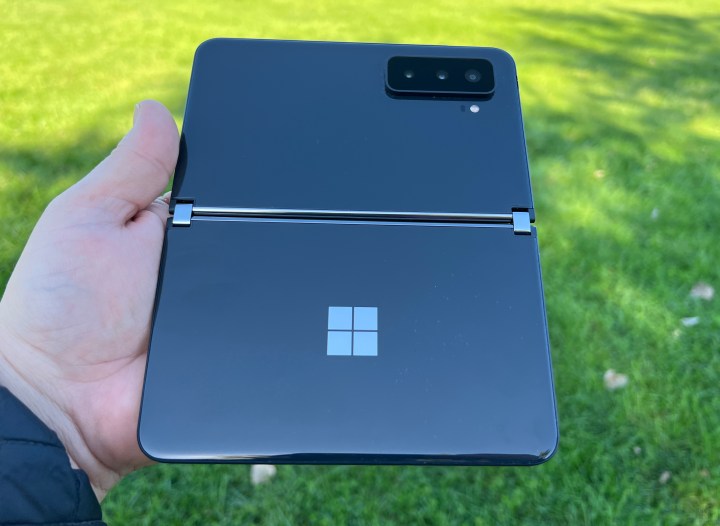
The Duo 2 and Fold 3 look nothing alike when it comes to design. The Duo 2 essentially resembles its predecessor, with no cover screen, a large and durable hinge between two separate displays, and a design language that resembles larger Surface devices like the Surface Pro 8 and Pro X. Instead of a cover screen, you get the Glance Bar, which is a gap between the hinge that lets you see the screen and offers color-coded notifications. The Fold 3, on the other hand, is like two Galaxy S21 phones melted together into a single screen, and it comes with a 6.2-inch cover display that supports 120Hz. The cover display offers extra usability you just don’t get with the Duo 2, which requires you to open it up each time to interact with it.
Separated by only a half-inch of screen space, the Microsoft Surface Duo 2 offers an 8.3-inch Dual AMOLED screen compared to the 7.6 inches Samsung provides when unfolded, but it’s important to note that the Fold 3 has a seamless folding screen (aside from the crease), while the Duo 2 still has the screen split by a bezel down the middle and a large one along the sides. The Duo also comes with 401 pixels per inch (ppi) thanks to its two 1892 x 1344 AMOLED high-definition resolution screens, which, when open, translates to a 2688 x 1892 AMOLED screen. However, regardless of when folded or when using the cover screen, the Fold 3 provides a bright, sharp AMOLED screen for social media, games, and video. This screen translates to a 2208 x 1768 resolution, or 374 ppi — putting it on par with the Duo 2 in terms of resolution despite some differences in pixel density.
More importantly, the hinges are what separate these smooth, sleek foldables. The Samsung Fold 3 offers a singular hinge for opening to a 7.6-inch panel. It’s like night and day compared to the Duo 2, which uses what it calls Revolutionary Hinge Technology for a full 360-degree fold. Keep in mind, this ultimate foldability comes at a refresh rate cost — you can expect an adaptive 90Hz refresh rate on the Duo compared to Samsung’s adaptive 120Hz rate. While you really can’t see a difference between 60Hz and 90Hz refresh rates, you may be able to spot the difference once you get up in those higher digits, which could impact mobile gaming experiences. Our reviewer particularly loved playing Genshin Impact on the Fold 3’s big screen.
Both phones also have Gorilla Glass Victus for better durability, though Samsung only has it on the cover screen despite having a more durable screen protector for the folding screen. The one big disparity is that the Fold 3 is IPX8 water-resistant, while the Duo 2 continues to lack it.
Winner: Samsung Galaxy Z Fold 3
Performance, battery life, and charging
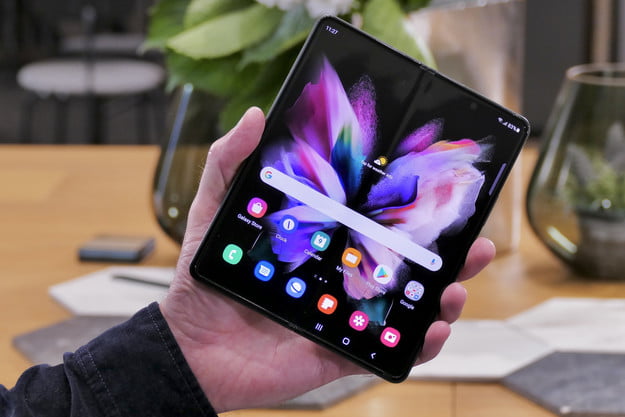
Both the Duo 2 and Fold 3 have Samsung’s latest Snapdragon 888 processor, which was one of the big criticisms of the previous Duo, which had an older Snapdragon 855. No matter what, you’re going to have 25% more CPU performance in either chipset as well as 35% more GPU performance. The Duo 2 comes with 8GB of RAM compared to the 12GB you get with the Fold 3, so you’ll be better able to handle intensive tasks and multitasking on the latter, though a lot of that comes down to software optimization. Still, it’s important to note the Surface Duo 2 has some bugs that need to be addressed and as a result, the software is a little lacking.
The Fold 3 had a somewhat disappointing battery life despite a 4,400mAh cell, and we found a nightly charge was needed to get through general daytime use, with over nine hours of runtime during a battery test. The Surface Duo 2 performed slightly better, offering 20% battery left at the end of a long and demanding day.
Thankfully, both models support fast charging and USB-C, but only the Fold 3 supports wireless charging. The Duo 2 still requires you to plug in, and it joins the rest of the market in not including an adapter, so you’ll need to buy a 23-watt one separately.
The Surface Duo 2’s battery is slightly stronger, but it’s still a tough category to score. This is a tie.
Winner: Tie
Camera
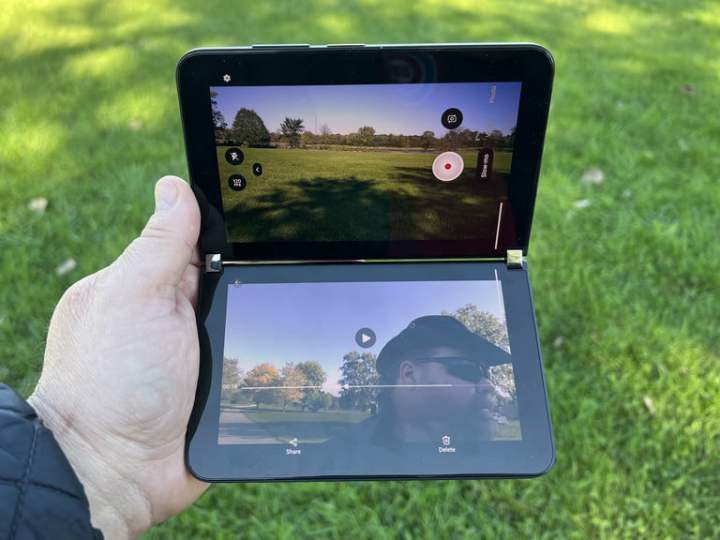
The Fold 3 offers a triple camera array with three 12-megapixel cameras that include a wide, telephoto, and ultrawide lens, a 10MP cover camera, and 4MP under-display selfie camera. The Duo 2, by contrast, has a 12MP wide, 12MP telephoto, and 16MP ultrawide rear camera array, plus a 12MP selfie camera. On paper, this sounds fairly similar, and users will be able to get the zoom and ultrawide shots that people have come to love. But Samsung has a much better track record in optimizing camera performance. Our early testing of the Fold 3 showed pretty good photo capabilities on the whole and solid low-light performance despite some challenges.
Microsoft claims the Duo 2 has much-improved camera performance and revealed plenty of sample shots to prove it. Most of them look pretty good, and, generally speaking, most modern smartphones fare well in good lighting conditions, and we particularly enjoyed the daytime photography on the Duo 2 during testing. However, our reviewer found nighttime photography on this device was lacking, especially compared to its competitors. The Duo 2 is also capable of 4K video recording at 30/60 fps, just like the Fold 3.
The Surface Duo 2 is a leap up in camera performance for this range, but the Galaxy Z Fold 3’s heritage is too strong.
Winner: Samsung Galaxy Z Fold 3
Software and connectivity

The software was the big downfall of the original Duo, with lots of bugs and very little of the seamless performance that was promised for multitasking and productivity. Microsoft has promised to rectify that for this model and says that consumers will finally get the performance they’ve been expecting with seamless switching between Book, Compose, and Tent mode. Once again, we found some bugs still aren’t worked out. But it should also be optimized for 150 games out of the box, letting you use the top screen for the game and the bottom screen for controls.
The Fold 3 has plenty of multitasking and productivity features, letting you run two apps side by side, launch apps together with App Pair, continue working from the cover screen to the unfolded screen with Continuity, and have up to three apps open at a time in resizable windows. Samsung also has a better track record when it comes to software for foldables, considering this is the third generation of its devices.
Updates are tougher to gauge. If you’re concerned about missing out on the latest software, then you need not worry about either of these models: Both run Android 11 OS and are certain to get Android 12. The question is simply: When? Samsung’s record is strong, and though the company hasn’t always been the fastest to update, it’s getting faster and it’s covering more devices. Microsoft is much more untested in this arena, and while we’re confident we’ll see plenty of updates for the Duo 2, Microsoft just doesn’t have the record Samsung does, so we’re giving this to Samsung for now.
Winner: Samsung Galaxy Z Fold 3
Special features

Both the Duo 2 and Fold 3 come with 5G connectivity. That’s not a big deal for Samsung, but it was a major omission on the original Duo, so it’s nice to see that fixed. Other connectivity protocols are largely identical, including the latest version of Bluetooth and NFC for contactless payment. Samsung also has the bonus of having launched more devices with larger screens, and you can really take advantage of that big seamless screen in a way that’s harder to do with the Surface Duo 2’s separate displays.
What about accessory support? The Duo 2 is compatible with the Surface Slim Pen 2, and that stylus can charge while sitting on the device. The Fold 3 is compatible with the S Pen Fold Edition and S Pen Pro, letting you draw, write, and take notes — but the downside is there’s no place to dock it on the device unless you get a compatible case.
Winner: Tie
Price and availability
Pre-orders for the Surface Duo 2 started on October 20. Prices start at $1,499, which is certainly a large chunk of dollars.
If you don’t want to wait that long or if you prefer to stay in the Samsung family, the Samsung Z Fold 3 is out now and costs $1,799. Samsung has lately been running some sales on the Fold 3, so there’s a chance you may be able to snag it for a lower price, especially with their phone trade-in program. The price difference isn’t huge, but it does make the Duo 2 a bit cheaper — which seems fair because it’s still missing a few features.
Winner: Microsoft Surface Duo 2
Overall winner: Samsung Galaxy Z Fold 3
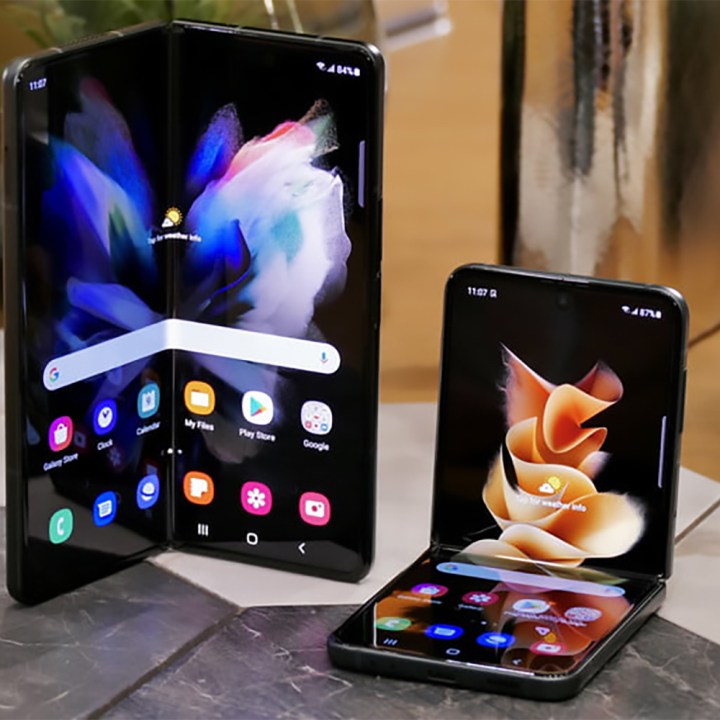
While impressed by the improvements Microsoft has made to the Duo 2, including the better processor, 5G connectivity, and 90Hz screen, the Fold 3 still has a lot more going for it in terms of refresh rate, software track record, and overall design. It also has several key features that are important for a current phone like wireless charging and water resistance. If you want a foldable you can rely on, we recommend going with Samsung.
Editors' Recommendations
- The Galaxy Z Fold 6 and Flip 6 release date just leaked
- The best Samsung Galaxy Z Fold 5 deals in March 2024
- Samsung Galaxy Z Fold 6: news, rumored price, release date, and more
- New Galaxy Z Fold 5 and Flip 5 features are heading to older devices
- Is the Samsung Galaxy Z Fold 5 waterproof?



